
Ever wondered about the man whose words danced to the rhythm of jazz and whose pen painted the Harlem Renaissance with vibrant shades of African American culture? Langston Hughes was more than just a poet; he was a beacon for change in a time when voices like his were often silenced. Born in Joplin, Missouri, in 1902, Hughes used his literary talents to highlight the joys, struggles, and the undying spirit of the Black community. From his iconic poem "The Negro Speaks of Rivers" to his influential role in the development of jazz poetry, Hughes left an indelible mark on American literature. But how much do you really know about him? Here are 20 fascinating facts about Langston Hughes that will give you a glimpse into the life and legacy of this literary giant. Ready to get jazzed up on knowledge? Let's dive into the world of Langston Hughes and uncover the stories behind the man who used his words as a force for change.
Key Takeaways:
- Langston Hughes was a prolific writer and key figure in the Harlem Renaissance, using his poetry to champion racial equality and inspire activists worldwide.
- Hughes's global influence and commitment to portraying the beauty and complexity of black experiences continue to inspire new generations to dream and fight for a better world.
Who Was Langston Hughes?
Langston Hughes was a central figure in the Harlem Renaissance, a flowering of African American cultural and intellectual life during the 1920s and 1930s. Born on February 1, 1902, in Joplin, Missouri, Hughes was a prolific writer whose work included poetry, novels, plays, and essays. He is best known for his insightful and beautiful portrayals of black life in America from the twenties through the sixties.
Early Life and Education
-
Hughes's early life was marked by instability and movement. His parents separated soon after his birth, and he was raised primarily by his grandmother until she died when he was a teenager. After her death, Hughes lived with various family members.
-
Despite the challenges of his early years, Hughes was a voracious reader and showed an early interest in writing. He began writing poetry in high school in Cleveland, Ohio.
-
Hughes attended Columbia University for a year but left due to racial prejudice and a lack of support for his literary ambitions. He later graduated from Lincoln University, a historically black college in Pennsylvania.
Hughes and the Harlem Renaissance
-
Hughes's writing career took off during the Harlem Renaissance, where he quickly became one of its most prominent figures. His poem "The Negro Speaks of Rivers," written when he was just 18, was widely acclaimed.
-
His work during this period was characterized by a commitment to portraying the authentic voices and experiences of African Americans. He often wrote in a jazz-inspired rhythm, capturing the vibrancy of Harlem life.
-
Hughes was not just a poet but also a key figure in promoting African American arts. He encouraged and supported other writers and artists, helping to foster a rich cultural environment in Harlem.
Langston Hughes's Literary Works
-
Hughes published his first poetry collection, "The Weary Blues," in 1926. This book included "The Negro Speaks of Rivers" and other poems that showcased his talent for incorporating jazz rhythms and African American vernacular into his work.
-
Over his career, Hughes wrote more than a dozen poetry collections, including "Montage of a Dream Deferred" and "Let America Be America Again."
-
Besides poetry, Hughes was a prolific writer of plays, novels, and short stories. His novel "Not Without Laughter" (1930) won the Harmon gold medal for literature.
-
Hughes was also known for his creation of the character Jesse B. Semple, affectionately known as "Simple," who appeared in a series of humorous and insightful columns in the Chicago Defender and later in book form.
Hughes's Impact and Legacy
-
Hughes's work had a significant impact on the civil rights movement. His poems and essays spoke to the struggles and injustices faced by African Americans and inspired many activists.
-
He was a pioneer in using jazz and the blues in literary form, influencing not only future generations of African American writers but also musicians and playwrights.
-
Hughes's home in Harlem has been designated a New York City Landmark, and his legacy is celebrated in various ways, including schools and libraries named after him.
-
Despite facing criticism from some peers for his focus on lower-class African American life, Hughes remained committed to portraying the beauty and complexity of black experiences in America.
-
Hughes passed away from complications of prostate cancer on May 22, 1967, but his work continues to be celebrated and studied for its profound impact on American literature and culture.
Hughes's Global Influence
-
Hughes's influence extended beyond the United States. He traveled extensively, including to the Soviet Union, Africa, and the Caribbean, which influenced his writing and perspective.
-
His work has been translated into multiple languages, making him an internationally recognized literary figure. Hughes's poetry and essays have inspired writers and activists around the world.
-
Hughes was deeply interested in the connections between African American culture and other cultures of the African diaspora. He explored these themes in his writing, contributing to a broader understanding of global black experiences.
Conclusion
-
Langston Hughes was more than just a writer; he was a voice for the voiceless, a champion for racial equality, and a pivotal figure in American literature. His legacy lives on, not only in his written works but in the spirit of diversity and creativity he championed throughout his life.
-
Through his vivid portrayals of black American life, Hughes offered a vision of equality and justice that remains relevant today. His work continues to inspire new generations to dream and to fight for a better world.
A Look Back at Langston Hughes' Legacy
Langston Hughes left an indelible mark on the world of literature and civil rights, weaving together narratives that spanned the complexities of the African American experience. His work, rich in cultural heritage and bold in its exploration of social issues, continues to inspire readers and writers alike. Through his poetry, plays, and essays, Hughes championed the beauty of black identity, challenged societal norms, and advocated for equality. His legacy is not just in the words he penned but in the conversations and changes those words ignited. As we reflect on his contributions, it's clear that Hughes' voice remains a powerful echo in the fight for justice and the celebration of diversity. His stories, a testament to resilience and creativity, encourage us to keep pushing boundaries and to find our own ways to make a difference. Hughes' journey reminds us of the enduring power of art to spark change and connect hearts.
Frequently Asked Questions
Was this page helpful?
Our commitment to delivering trustworthy and engaging content is at the heart of what we do. Each fact on our site is contributed by real users like you, bringing a wealth of diverse insights and information. To ensure the highest standards of accuracy and reliability, our dedicated editors meticulously review each submission. This process guarantees that the facts we share are not only fascinating but also credible. Trust in our commitment to quality and authenticity as you explore and learn with us.


